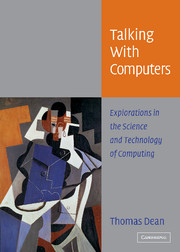Book contents
- Frontmatter
- Contents
- Preface
- Acknowledgments
- 1 TALKING WITH COMPUTERS
- 2 THE SHELL GAME
- 3 KEEPING TRACK OF YOUR STUFF
- 4 DON'T SWEAT THE SYNTAX
- 5 COMPUTATIONAL MUDDLES
- 6 GETTING ORIENTED
- 7 THANKS FOR SHARING
- 8 YOU'VE GOT (JUNK) EMAIL
- 9 MODERN ARCHITECTURE
- 10 DO ROBOTS SLEEP?
- 11 UNDER THE HOOD
- 12 ANALYZE THIS
- 13 FOREST FOR THE TREES
- 14 SEARCHING THE WILD WEB
- 15 DARWIN'S DANGEROUS ALGORITHM
- 16 AIN'T NOBODY HERE BUT US MACHINES
- Bibliography
- Index
15 - DARWIN'S DANGEROUS ALGORITHM
Published online by Cambridge University Press: 05 June 2012
- Frontmatter
- Contents
- Preface
- Acknowledgments
- 1 TALKING WITH COMPUTERS
- 2 THE SHELL GAME
- 3 KEEPING TRACK OF YOUR STUFF
- 4 DON'T SWEAT THE SYNTAX
- 5 COMPUTATIONAL MUDDLES
- 6 GETTING ORIENTED
- 7 THANKS FOR SHARING
- 8 YOU'VE GOT (JUNK) EMAIL
- 9 MODERN ARCHITECTURE
- 10 DO ROBOTS SLEEP?
- 11 UNDER THE HOOD
- 12 ANALYZE THIS
- 13 FOREST FOR THE TREES
- 14 SEARCHING THE WILD WEB
- 15 DARWIN'S DANGEROUS ALGORITHM
- 16 AIN'T NOBODY HERE BUT US MACHINES
- Bibliography
- Index
Summary
In Daniel Dennett's Darwin's Dangerous Idea: Evolution and the Meanings of Life, the dangerous idea is natural selection, Charles Darwin's name for the mechanism governing the evolution of species that he codiscovered with Alfred Russel Wallace. Natural selection is the “process by which individual characteristics that are more favorable to reproductive success are ‘chosen,’ because they are passed on from one generation to the next, over characteristics that are less favorable”.
Natural selection explains how characteristics that promote reproductive success persist and under certain circumstances can come to dominate less favorable characteristics, but it doesn't explain how those characteristics are passed on or how new characteristics come into being. It was Gregor Mendel, living around Darwin's time, who suggested that heritable characteristics are packaged in the discrete units we now call genes and that offspring inherit a combination of their parents' genes.
When you combine Darwin's and Mendel's ideas, you have the basis for genetic algorithms, an interesting class of algorithms generally attributed to John Holland that take their inspiration from evolutionary biology. These algorithms simulate some aspects of biological evolution – while ignoring others – to tackle a wide range of problems from designing circuits to scheduling trains. Genetic algorithms allow the algorithm designer to specify the criterion for reproductive success by supplying a fitness function, alluding to the idea that in a competitive environment only the fittest survive to reproduce.
- Type
- Chapter
- Information
- Talking with ComputersExplorations in the Science and Technology of Computing, pp. 257 - 270Publisher: Cambridge University PressPrint publication year: 2004



